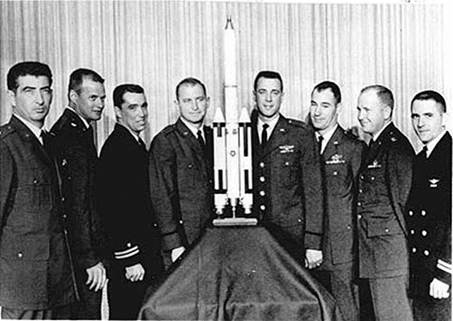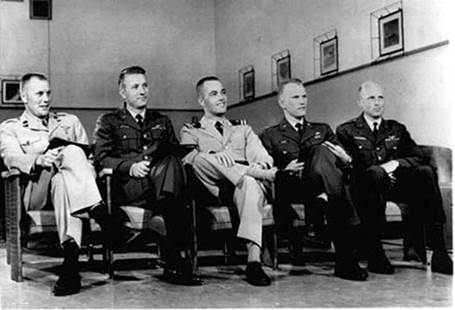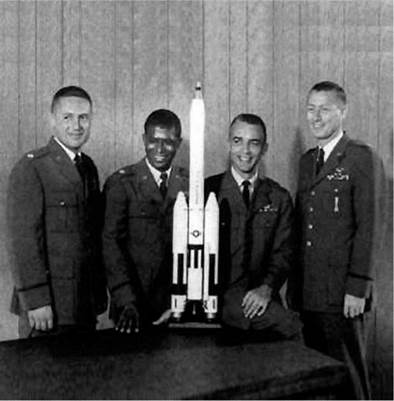MANNED ORBITING LABORATORY (MOL)—UNITED STATES DEPARTMENT OF DEFENSE
With NASA now enjoying great success with their manned spaceflight program, the U. S. Air Force wanted to be more involved. Their earlier project DynaSoar, which
was to have been a manned orbital space plane, was in budgetary limbo, and NASA had not selected as many Air Force candidates for astronaut training as the top brass would have liked. Air Force manned space projects were not new: before Project Mercury it had created the “Man In Space Soonest” or MISS program, but this had been ignored when President Eisenhower decided in 1958 that he wanted manned spaceflight to be handled by a civilian agency, and established NASA.
In 1962, the USAF began to look closely at the proposed Gemini program, and realised that it held great potential to be modified for Air Force use, it had the added bonus that it would be tested first by NASA and it would be ready to fly much earlier than their own DynaSoar. With the addition of a cylindrical pressurized habitat that would be launched attached to the bottom of a modified Gemini spacecraft, the idea grew into MODS, or the Manned Orbital Development Station. However, even this interim project would not be ready early enough in the eyes of the Air Force brass, and it was proposed to fly a number of Gemini missions, in partnership with NASA, under the banner of “Blue Gemini”. Unfortunately, the potential of this joint program was undermined when Secretary of Defense Robert McNamara demanded that not only should the Air Force take over the entire Gemini program, but all future low-Earth-orbit missions as well. NASA officials were naturally aghast at this prospect, and protested strongly that such a move would destroy America’s plans to land on the moon by the end of the decade. Perhaps more surprisingly, senior USAF officers were similarly opposed to this plan, because they did not want their interim plans for a Blue Gemini, which they viewed purely as a means of gaining flight experience, to interfere with the larger DynaSoar project for which they had great hopes. Upon hearing of the Air Force’s objections McNamara appeared to back down, and a new agreement was reached which merely allowed the installation of Air Force experiments on NASA Gemini flights. No sooner had this been agreed, McNamara took his revenge for the USAF’s lack of support as he saw it, and cancelled both Project MODS and Blue Gemini. In fact these were just two of thirteen new projects for which the Air Force had sought funding in January 1963, and McNamara canceled them all, bringing to mind something about a secretary scorned! In December 1963 he rounded it all off by canceling DynaSoar as well. A bone was thrown to the Air Force, however, in the form of a new project known as the Manned Orbiting Laboratory (MOL). Essentially, MOL was MODS reborn. MOL was to be launched with its crew in a Gemini capsule, to be used once, and then discarded.
It was not until August 1965 that official funding for MOL came through when President Johnson allocated $1.5 billion to the program. With the program now in development, it was decided to begin the construction of launch facilities. MOL called for a base that could launch the vehicle into a polar orbit, a first for manned spaceflight, and so Vandenberg Air Force base on the California coast was chosen. Construction began in March 1966 of Space Launch Complex 6, or Slick 6 as it became known. The first real success of the MOL program came in November that same year when an already flown Gemini spacecraft, that had been modified to have a hatch installed in its heatshield, was launched not from Vandenberg but from Cape Canaveral atop of a Titan IIIC booster with a Titan II propellant tank standing in for the MOL beneath the capsule. The capsule was successfully recovered and represented the first reusable spacecraft launch and recovery. However, by the end of that first year, despite continuing progress, the program was faltering under the load of ever increasing costs, and a falling budget. Also becoming a problem was the ever increasing weight of the MOL combination, which in turn required the man-rated version of the Titan IIIC, known as the Titan IIIM, to be upgraded with additional segments to its solid rocket boosters. However, despite the program’s difficulties, progress was being made, Slick 6 was nearing completion, and the Air Force had recruited 14 astronauts.
The MOL pilots were recruited in three groups in much the same way that NASA appointed its astronauts. The first group, which was chosen in 1965, consisted of eight pilots; six from the U. S. Air Force, and perhaps surprisingly, two from the U. S. Navy. They were:
Michael J. Adams, USAF Albert H. Crews, USAF John L. Finley, USN Richard E. Lawyer, USAF Lachlan Macleay, USAF Francis G. Neubeck, USAF James M. Taylor, USAF Richard H. Truly, USN
This group was different from the NASA astronaut selections in that they were all active military, and were all pilots, a moniker that they retained rather than calling themselves astronauts. All were handpicked from a list of Aerospace Research Pilot School (ARPS) students, instructors, and graduates by Chuck Yeager, the ARPS commandant.
The second group were selected the following year, and consisted of five more pilots:
Robert F. (Bob) Overmyer, USMC Henry W. (Hank) Hartsfield, USAF Robert L. Crippen, USN Karol J. Bobko, USAF Charles Gordon Fullerton, USAF
Again, one year later, in 1967, a third and final group was chosen, only four pilots this time:
Robert T. Herres, USAF Robert H. Lawrence, Jr., USAF Dr. Donald H. Peterson, USAF James A. Abrahamson, USAF
|
First MOL astronaut selection |
|
Second MOL astronaut selection |
|
Third MOL astronaut selection |
Of these fourteen pilots nearly all would go on to continue their careers with some distinction. From the first group, Mike Adams left the MOL program and transferred to the USAF X-15 program where he successfully completed six flights before he was killed on his seventh flight after the aircraft experienced technical difficulties that put it into a spin at about 206,000 ft. Adams recovered from this spin, but the aircraft disintegrated under the 15 g loads and fell from the sky. Richard Lawyer left and had a distinguished test pilot career, before re-entering the MOL story toward the end of his life as we will discuss later. Robert Lawrence would have been the first African American in space, but he was killed in 1967 whilst flying in the backseat of an F104 on an ARPS mission to practise X-15-type landing approaches. The pilot of the aircraft, Major Harvey Royer, misjudged his approach and hit the runway hard, the undercarriage collapsing and launching the aircraft back into the air, now ablaze at its rear. It landed 2,000 ft further down the runway and disintegrated as it bounced once more. Both pilots ejected successfully, but Lawrence’s parachute failed to deploy, and he was killed—Major Royer survived the accident.
The MOL program received a shock in June 1969. All of the major program officials fully realized that the program was late and over budget, and they certainly feared that when the budgets were announced that would be left short, but it seems that no-one had actually considered complete cancellation of the project, which is what President Richard Nixon did. The MOL pilots were offered the opportunity to transfer to NASA. Seven took up the offer, and all went on to become important members of the space shuttle program. Richard Truly flew STS-2 and STS-8 before retiring from NASA, and later became the 8th NASA Administrator between 1989 and 1992. Robert Crippen was the pilot of the very first space shuttle flight aboard Columbia in 1981, and went on to fly two more missions as shuttle commander. Ironically he was to command the first mission of the space shuttle from the same Vandenberg Slick 6 launch complex that MOL was to have launched from, but that mission was canceled after the Challenger accident, and Crippen retired from NASA. He too later returned in a management capacity, acting as Director of the Johnson Space Center between 1992 and 1995. Karol Bobko also flew the shuttle three times, once as pilot and twice as commander. Bobko is still involved in the spaceflight business as Vice President of SpaceHab. Gordon Fullerton still works for NASA as a research pilot. He flew Enterprise in the Approach and Landing tests, and later on STS-3 and STS-51F, the latter a Spacelab mission which to this date holds the distinction of being the only in-flight abort of the shuttle program. Henry Hartsfield was another to fly the shuttle three times, once as pilot on STS-4, and twice when he commanded STS-41D, the first flight of Discovery, and STS-61A, a Spacelab mission that was the first in history to have an eight-person crew. Unfortunately, Bob Overmeyer was killed in March 1996 whilst piloting an aerobatic aircraft; but he had successfully flown two shuttle flights, his first as pilot on board the first operational shuttle flight, STS-5, and the second in command of flight STS-51B, a Spacelab mission. Don Peterson flew just one mission on the space shuttle, STS-6, and was the only member of his group not to fly as pilot but as mission specialist. However, his mission specialist designation allowed him also to be the only member of the group to carry out a spacewalk.
Colonel Richard Lawyer re-enters our story in June of 2005, when artefacts from the abandoned MOL program were found at Cape Canaveral Air Force Station in Florida. A room at the launch complex 5/6 museum that had apparently not been opened for many years was being checked by security officers when two blue MOL spacesuits that had been used for training were found to be in almost perfect condition, one belonged to Lt. Col. Richard Lawyer. Other MOL spacesuits are on display at the USAF Museum in Dayton Ohio, and at the Johnson Space Center. The two newly discovered suits were donated to the Smithsonian Institution. Unfortunately Colonel Lawyer died later that same year. To the very end he had kept his vow to keep his country’s secrets. While very forthcoming about general aspects of the MOL program, he would never say a word about its actual mission. He would simply say, “I am not at liberty to deny or confirm the reported mission for MOL.’’













